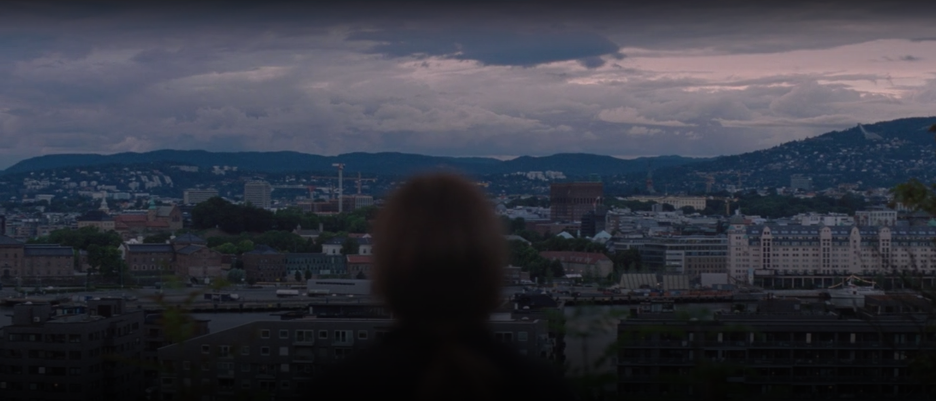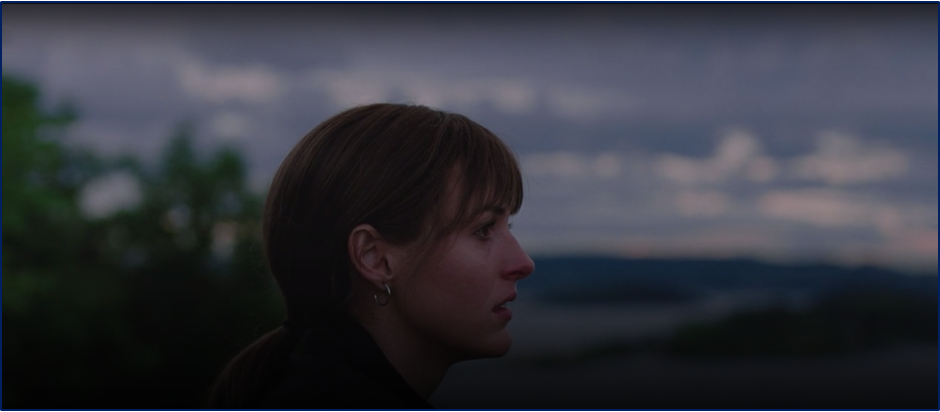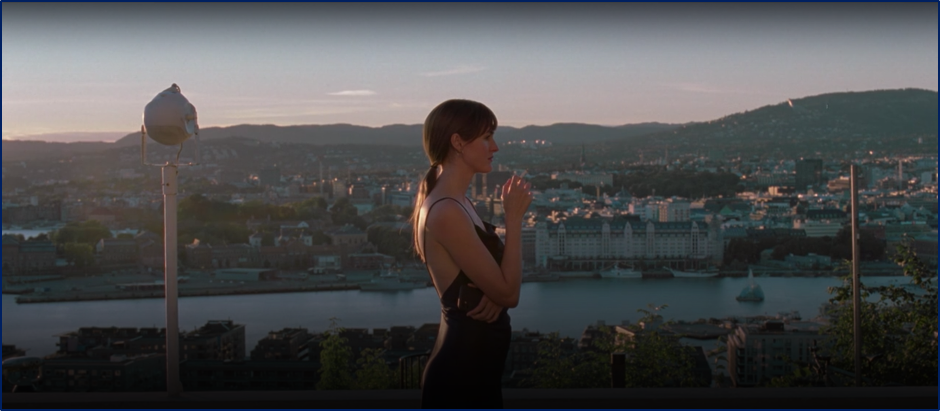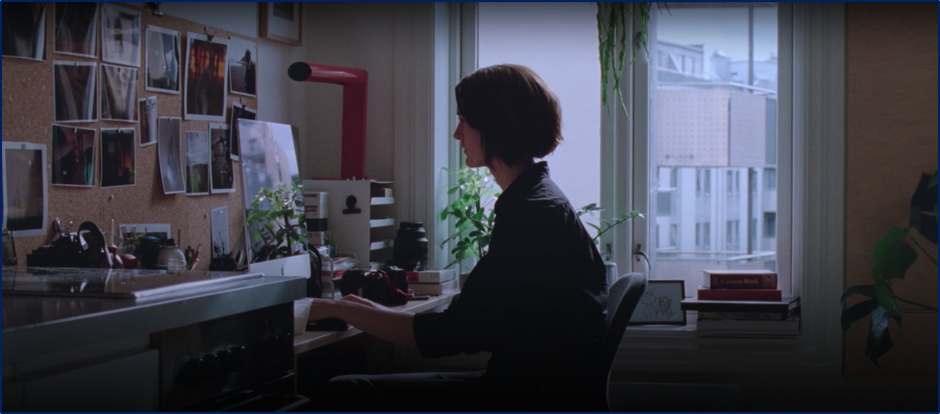Heteropessimism
About twenty-five minutes into Joachim Trier's 2021 film The Worst Person in the World, protagonist Julie is leaving a party where her boyfriend was being annoying. She is enjoying a scenic stroll home when she finds herself on a ridge overlooking Oslo. The camera positions itself behind her head, showing us the wide, blue horizon above her and the city stretching out below, as though she is the Wanderer above a Sea of Fog.


Slowly, the camera pans around from the horizon to her face, and we see her giddy smile freeze, then fall into a mask of wide-eyed terror, as her eyes fill with tears (Fig. 1). It is a mysterious and arresting moment, and one key to understanding the film: why is this woman, in a brief respite between boyfriends, crying, terrified, as she glimpses the wide-openness of the world?
Oslo is a flat city flanked by hills, but the film frequently depicts it from above, making the city look sprawling. The horizon created where these hills touch the sky is an important motif throughout The Worst Person in the World. The opening shot of the film, for example, offers us a tableau: Julie, in the foreground, smokes a cigarette as she looks off-screen. In the background, the horizon over Oslo cuts her head in half (Fig. 2). She begins walking toward the camera, before looking over her shoulder at the city behind her. Slowly, she takes a deep breath, then sighs.

These shots capture Julie's despair at the horizons of her own life. But why? What is it about her imagination of her future that leads her to grief? One answer is that Julie's sense of future promise is bound up in her consistently disappointing relationships with men (Along with The Worst Person in the World, Ryan Lackey also deploys the horizon as a metaphor for the limits of heterosexual romance in his essay on Ted Lasso.) From the prologue (this film has chapters) to its last act, the narrative beats of The Worst Person in the World follow the ups-and-downs of Julie's romantic life. There are initial meet-cutes with various men; first dates with a few; the move-in stage and the flutterings of domestic bliss with two. Despite these feints towards a rom-com plot, Julie never gets the ending we anticipate for a rom-com heroine. She goes from bad relationship, to worse relationship, to pandemic-time loneliness. Finally, the film ends with a shot that couldn't be more diametrically opposed to the one that starts it: Julie, alone in her small apartment, hunched over her laptop (fig. 3). The horizon is gone, but nothing has replaced it. And while in the film's opening shot she looked rightward, toward the future, she now faces the opposite direction. What could be a better expression of this film's thoroughly pessimistic attitude toward heterosexuality than its final image?

The film weaves together Julie's narrative with tropes of the rom-com genre in order to recount a tragedy about failed romance. In The Worst Person in the World, the fantasy of fulfilling heterosexual romance and the beats of the rom-com genre become inextricable from one another, so it is hard to unlink Julie's declining optimism about heterosexuality from the decline of the rom-com genre itself, and perhaps even from the inescapable subject that haunts most contemporary films: the quote-unquote Death of Cinema. In other words, the film (like Annabel Barry's essay on Sally Rooney) suggests that heterosexual romance is structured around aesthetic forms, and that a poverty of those forms in popular culture corresponds to a prevailing pessimism about heterosexuality itself. By "poverty" I mean the decline of the popularity, box office reliability and cultural purchase of the rom-com, not to a new situation in which rom-coms are no longer produced, since this is not true. I might note that new rom-coms register the "death" of the genre by constantly self-consciously positioning themselves as "rom-com revivals," but I will have more to say on that later.
In the prologue's montage, Julie vacillates between studying medicine, psychology and photography; similarly, she cuts between short-lived, unfulfilling relationships with boyfriends. Eventually, despairing, she starts a relationship with a comic book artist whose work she only remembers for its vague sexism, and whom she only realizes she loves in the moment when he tells her he's emotionally unavailable for a relationship. About a third of the way into the film, they break up. Later, she starts dating a guy who comes into the bookstore where she works, and with whom she had previously flirted at a party while they were both dating other people. This relationship, too, comes to disappointment.
Despite pursuing, at every opportunity, the kinds of spontaneous rendezvous that, in rom-coms, usually lead to happy romances, Julie ends up foiled again and again by a romantic plotline that just won't cohere. Repeated failures lead to despair, and by the end of the film, she finds herself in the aforementioned cramped apartment, a tragic heroine.
With satirical references to the state of contemporary gender politics, the film suggests that the rom-com ending Julie hopes for is impossible today, in the wake of #MeToo, but also simply at this juncture in history. Julie establishes her feminist bona fides by writing an essay on "Oral Sex in the Age of #MeToo," which goes viral. Later, when her boyfriend gets canceled for his problematic illustrations and an interview where he uses rhetoric vaguely in line with the online right, it becomes clear to an audience that increasingly irreconcilable political differences between straight men and women represent an insurmountable obstacle to their relationship. The failure of a rom-com plot to materialize thus seems to correspond to a broader cultural pessimism about the possibilities of fulfilling heterosexual relationships after GamerGate and #MeToo.
Although The Worst Person in the World seems to suggest the incoherence of the rom-com genre in our heteropessimist moment, it has been heralded as one of the most 'believable' rom-coms in recent memory. Slant, for example, calls it a "euphoric rom com" that will "restore your faith in the genre," a quote featured in the film's trailer.1 This, despite the fact that the film ends with the protagonist single, alone, underemployed, and miserable — exactly the opposite of how one would expect a rom-com hero to wind up. So, how can the film both "restore your faith" in the rom-com genre and subvert every expectation about that genre? The description of the film as a "rom-com restoration project" comes perhaps from the way it captures what it feels like to live in an age where the rom-com genre is - to borrow Lauren Berlant's phrase - "flailing." This, Berlant notes, is brought about by "the failure of the political world to be worthy of our attachment to it."2 #MeToo brought to public consciousness thousands of women's stories about the intolerability of their interactions with men. The most believable romance, then, is the one that acknowledges how the political world of contemporary gender politics is "unworthy of our attachment to it."
To restore the rom-com, The Worst Person in the World takes the genre apart. Heteropessimism is defined around such contradictions. Contradiction is the glue holding heterosexuality together; taking the form of something like the sentiment that "men are trash" even as we date them (as Chiara Giovanni explores in her essay on contemporary romance novels). The Worst Person in the World gains credibility as a rom-com not only in spite, but because of its performance of the flailing of the genre. Only through this formal "glitching" or stuttering, which causes the rom-com plot to start over and over and then not conclude as expected, can the film respond to a time in gender politics that is itself out of joint.
In the background of The Worst Person in the World's performative undermining of rom-com tropes is the real economic and cultural decline of the rom-com. An essay at Screenrant gives a persuasive account of the forces behind the fall of this former box office tentpole:
The rom-com that had been such a fan favorite in the '90s and into the early 2000's never quite had the opportunity to reboot itself . . . Spurned [sic] on by the likes of Judd Apatow and Nicholas Stoller, comedies found raunchier, yet somehow more realistic approaches to dealing with love, which in turn were often wildly successful. This made a return to the traditional uniformity of the rom-com all but impossible. It was as if the genre failed to recognize its own flawed approach and was therefore replaced by something slightly similar but far better suited for a new generation of audiences. The eternally optimistic romanticism of the rom-com was a thing of the past, and even if it did have life in it, there seemed little chance that it could compete with the bawdier comedies that had become the norm.3
In other words, it was rom-coms' "optimistic" attitude that led to dwindling box office numbers. And recent attempts to revive the rom-com at the cinema have only confirmed the unprofitability of this optimism. Recent queer rom-com Bros predicts its own box office problems in its script. In one early scene, a movie exec asks protagonist Bobby (played by the film's writer Billy Eichner) to write a "nice movie about nice gay people." Bobby responds, "well there's your first mistake: not all gay people are nice." The film, whose plot contradicts this early meta-comment by attempting to reveal the hidden kindness of its superficially surly protagonist, was a notorious box office failure, ironically proving Bobby's comment to be valid. There is something essentially hetero-optimistic about the rom-com, with its "paradigm" of balancing "male and female friendships, marriage and work."4 As a failed studio attempt to queer the genre, Bros only underscores the rom-com's irrelevance in an age of heteropessimism. Thus, The Worst Person in the World gets as close to a rom-com as you can get in this post-rom-com era, by making the economic and cultural conditions that killed the rom-com legible in the film's form. Owen Gleiberman writes for Variety what could be a tagline for The Worst Person in the World: "the rom-com is dead. Long live the rom-com."5
The Worst Person in the World presents not only a flailing of genre, but of medium, linking the death of the rom-com to the death of cinema. With a never-explained, almost perfunctory voiceover narrator and intertitles with chapter headings (including a "prologue" and an "epilogue,") the film begins by leaving the viewer on unstable ground, not only between rom-com and drama but between film and novel. This formal undermining of film's medium specificity is paralleled by diegetic references to the economic forces often blamed for the undermining of cinema's cultural importance. In a close-up on Julie's laptop screen in the film's final scene, we see that she is cropping on-set photos she's taken of an actress in an unnamed film having an emotional breakdown. Having spent most of its running time subverting our expectations that it will conform to the structures of a mainstream box office staple, The Worst Person in the World ends with Julie participating in the phenomenon that has arguably done more damage to the institution of cinema than any other. As Martin Scorsese complains in his 2021 essay "Il Maestro," "the art of cinema is being systematically devalued, sidelined, demeaned, and reduced to its lowest common denominator, 'content.'"6At the end of the film, we watch Julie perform this "reduction" of cinema to content in real-time, editing photos presumably for press junkets, blogs, social media, or some other Internet outlet. The film ends by drawing direct connections between Julie's failures to secure a fulfilling heterosexual romance, the decline of the rom-com genre, and the "demeaning" of the institution of the cinema altogether.
Interestingly, the phenomenon Scorsese criticizes in that essay is the same one responsible for the decline of the rom-com at the box office: the increasing reliance on existing intellectual property for all new commercial film endeavors. As Scott Meslow, author of Rise and Fall (and Rise Again) of the Romantic Comedy, notes, "Romantic comedies largely disappeared at the studios for the same reason that most mid-budget movies started to disappear: Hollywood favored . . . mass blockbusters or traditional awards fare, with very little happening between those two poles."7 Heterosexuality and cinema, twinned institutions that have long held each other up, both seem to be crumbling together at the end of The Worst Person in the World. In a devastating moment of self-parody, the film concludes with Julie, a sad woman in a film, turning a film about a sad woman into a mere meme.
At the end of the film, Julie is "devalued, sidelined, demeaned and reduced," by the same phenomenon crushing the institution of cinema — the content industry, into which she finds herself conscripted. That last shot of Julie is notable because it shows not only her romantic loneliness but also how alienating her job has become. From the earliest examples of the genre, the rom-com has dealt with the demands on women to balance work with romance. In The Worst Person in the World, Julie's struggles to find meaningful work parallel her difficulty finding fulfilling relationships with men. In the prologue, a montage shows the parallel tracks on which Julie pursues multiple boyfriends and careers, none of which stick. The film mobilizes a failed rom-com plot, an unsatisfying search for a job, and references to the death of cinema in order to suggest an overarching problem at the heart of all three: an increasingly cold, alienating regime of capitalism that suppresses human relationships in life and at the box office.
Studios are still producing rom-coms in the streaming era. The reduction of film to content has not stopped the production of films as content. But these new rom-coms do not refute, but only underscore, that the genre is dead. The main way they do this is by constantly framing themselves as a "comeback" of the genre. In 2019, the Los Angeles Times wrote that Always Be My Maybe was facilitating a "rom-com revival."8 Alison Brie, creator of Somebody That I Used to Know (now streaming on Amazon Prime), acknowledged the inevitability of a revivalist narrative attaching itself to any new rom-com in a recent interview: "whenever you make a new rom-com, people are always like, 'is the rom-com back?'"9 That the rom-com has undergone a seismic decline in cultural purchase and needs to be "restored" or "revived" is not in question, even for new iterations of the genre. You don't revive things that are still alive.
New rom-coms understand themselves as belated examples of an antique genre. They reflect this not only in their marketing campaigns but in their form. As a recent IndieWire article points out, rom-coms have increasingly become reliant on references to 1990s-2000s examples of the genre to establish their legitimacy: "The rom-com as we know (and love) it is dead . . . So, why do contemporary films keep blatantly referencing them? The referential rom-com, once viewed as clever and quirky, has become the standard for a current crop of new movies."10 Somebody That I Used to Know, for example, repeats the narrative of My Best Friend's Wedding, and, in a pivotal scene near the climax, the protagonist explicitly compares herself to that film's heroine. Alison Brie explains in an interview, "You have to figure that characters in today's rom-coms have seen all of the rom-coms that the audience has seen." Even the narration in The Worst Person in the World seems to recall the disembodied narrators of early 2000s rom-com trailers. The IndieWire article concludes, "instead of reviving the high-concept rom-com, the genre has stooped to a new iteration of self-referential jokes in order to feel fresh in a postmodern world while simultaneously apologizing for its very lack of 'wish fulfillment.'" Far from demonstrating the vitality of the genre today, new rom-coms only underscore the irreconcilable differences between the genre and the economic and cultural landscape of contemporary cinema — not to mention the current state of gender relations. The genre today understands itself as repeating a bygone cultural moment; as a stuttering, a glitching, or an echo of the past, one that can't help but keep repeating the gestures of its precedents, the way The Worst Person in the World does, until, as in that film, those gestures start to look like flailing.
But as unreliable as the rom-com plot appears in The Worst Person in the World, the film is not a critique of the rom-com. It's a eulogy. Everything the rom-com promised: domestic happiness, the resolution of gendered conflicts, the possibility of romance, are still central motivations for Julie. When she doesn't achieve them, she doesn't find anything better waiting for her. Instead, she is left occupying a profound absence of possibility. Along with the death of cinema, the film also compels us to consider the end of straight history.
The end of The Worst Person in the World demonstrates that the collapse of institutions like heterosexuality or cinema need not open up onto a host of new possibilities, nor even Gramsci's "morbid symptoms." The horizon of heterosexuality was a painful sight for our protagonist, but its disappearance is not liberation; instead, she finds herself isolated in the horizonless prison of her apartment. The twin pessimisms of this film — toward heterosexual romance and the future of the film genre that has upheld it — ultimately produce a heteromelancholy with little room for solace, except perhaps that the existence of The Worst Person in the World itself gives us occasion to reflect on these dead or dying institutions, work through their passing, and begin to mourn.
Sean Lambert is a graduate student in UC Berkeley's German department. His research focuses on literary modernism, film and critical theory. He is currently working on a project on the history of automation as a trope in German literature and philosophy. In addition to academic publications in The German Studies Review and SubStance, he has published literary and film criticism in Current Affairs, Literature in Translation, The Cleveland Review of Books and Docalogue. He has also published fiction in the Chicago Review.
References
- Pat Brown, "The Worst Person in the World Review: A Euphoric Rom-Com Restoration Project." Slant. July 15, 2021.[⤒]
- Lauren Berlant, "Genre Flailing." In Capacious: Journal for Emerging Affect Inquiry 1, no. 2 (2018): 157-162.[⤒]
- Mike Jones, "Why Rom-Coms Died in the 2000s (& Why They're Coming Back)," Screenrant, September 20, 2020.[⤒]
- Betty Kaklamanidou, Genre, Gender and the Effects of Neoliberalism: the New Millennium Hollywood Rom Com (London and New York: Routledge, 2015), 2[⤒]
- Owen Gleiberman, "The Rom-Com Is Dead. Long Live the Rom-Com," Variety, Feb. 22, 2019.[⤒]
- Martin Scorsese, "Il Maestro," Harper's Magazine, 2021.[⤒]
- Quoted in Jessica Sager, "Are We in the Midst of a Rom-Com Renaissance? Yes, But Here's Why the Next Gen Won't — And Shouldn't — Look the Same," Parade, February 16, 2022.[⤒]
- Mark Olsen, "Review: Ali Wong and Randall Park continue rom-com revival with 'Always Be My Maybe,' Los Angeles Times, May 28, 2019.[⤒]
- Alison Brie interviewed by Matt Rogers and Bowen Yang, "Down . . . In . . . Finish," Las Culturistas (podcast), February 15, 2023.[⤒]
- Samantha Bergesen, "For Better or Worse, Referential Rom-Coms Are Everywhere This Valentine's Day," IndieWire, February 14, 2023.[⤒]
